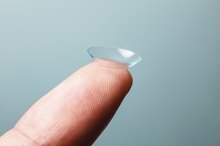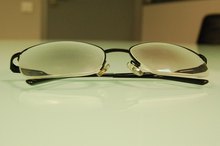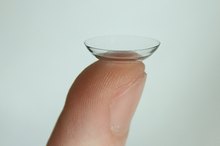How to Determine the Base Curve of a Contact Lens
You can order contact lenses online, but you need a valid prescription from your eye doctor. **Ordering online or by phone can save you money on your contacts, and you can choose from a large selection of products and accessories for your lenses.
Before ordering, though, you need to understand what the numbers on your contact-lens prescription represent.
** These numbers are different from those on your eyeglass prescription. Don't worry if you make a mistake filling out the information. The seller will verify your information and confirm it with your doctor, as required by law.
Locate the abbreviations on your prescription that stand for right or left eye. These are in the first column of your prescription. The Ocular Dexter (O.D.) is your right eye, and Ocular Sinister (O.S.) is your left eye. You may see initials like OU for both eyes or RE and LE for right eye and left eye, respectively.
What Do Prescription Numbers Mean in Eye Glasses?
Learn More
Move to the next column, which shows the sphere or power for your lenses. (Since contact lenses are closer to your eyes than your eyeglasses are, so your power requirements change.) This is a number between +20.0 and -20.0. For those with a plus, the closer the lens is to the eye makes the lens weaker for the wearer. If you have a negative number, the closer the lens is to the eye, the stronger the lens is.
Determine the base curve of your lenses. The next column represents the base curve (B.C. or B.C.R). This is the inside curve measurement of your lenses. Some brands offer only one base curve size, which is more common among brands of soft contact lenses. People who wear hard contact lenses need more choices when it comes to base curve sizes, because of the inflexible, rigid nature of these lenses. The base curve is a number from 8.0 to 10.0 on your prescription.
How to Convert a Contact Prescription to a Glasses Prescription
Learn More
Look at the last number on your prescription, which indicates the diameter of the lens. When you blink your eyes, your contact lenses move over the limbus, which is the part of your eye where the cornea meets the sclera. This is a seamless transition for most of those who wear soft contact lenses. For those who wear hard contact lenses, it is irritating and uncomfortable. The diameter is a number between 13.0 and 15.0.
Locate the two additional columns on prescriptions for toric lenses. Wearers with astigmatism may have additional columns on their prescription, with two numbers separated by an X. The cylinder should be a number between +4.00 and -4.00; this indicates the strength of your astigmatism. Those with severe astigmatism will have higher or lower cylinder numbers, which fluctuate over time as new technology breeds new products. The axis is a number between 0 and 180, and represents the orientation of your astigmatism.
Tips
These base curve values are similar to shoe sizes: With some brands, you may wear a different size. If your contact lens prescription does not have a base curve number, that brand only offers one base curve size.
Set up an account online with a distributor of contact lenses. You can get speedy lens replacements and automatic shipments. Set up reminders for visiting your doctor before your prescription runs out.
You have the right to get a prescription for contact lenses from your eye doctor. He must not charge you for the prescription, but he may charge you for the exam and contact-lens fitting. You are not required to purchase contact lenses from your eye doctor.
Warnings
You may not order another brand of contacts other than what the prescription indicates. If you want a different brand, you must have the eye doctor fit you and draw up another prescription.
Related Articles
References
- Kessel L, Andresen J, Tendal B, Erngaard D, Flesner P, Hjortdal J. Toric intraocular lenses in the correction of astigmatism during cataract surgery: a systematic review and meta-analysis. Ophthalmology. 2016;123(2):275-286. doi:10.1016/j.ophtha.2015.10.002
- Federal Trade Commission. The contact lens rule: a guide for prescribers and sellers. Published June 2020.
- Wu YT, Willcox M, Zhu H, Stapleton F. Contact lens hygiene compliance and lens case contamination: A review. Cont Lens Anterior Eye. 2015;38(5):307-316. doi:10.1016/j.clae.2015.04.007
- Cope JR, Collier SA, Srinivasan K, et al. Contact lens-related corneal infections - United States, 2005-2015. MMWR Morb Mortal Wkly Rep. 2016;65(32):817-20. doi:10.15585/mmwr.mm6532a2
- Cope JR, Konne NM, Jacobs DS, et al. Corneal infections associated with sleeping in contact lenses - six cases, United States, 2016-2018. MMWR Morb Mortal Wkly Rep. 2018;67(32):877-881. doi:10.15585/mmwr.mm6732a2
- Lam JSH, Tan G, Tan DTH, Mehta JS. Demographics and behaviour of patients with contact lens-related infectious keratitis in Singapore. Annals Academy of Medicine. 2013;42(10):499-506.
- American Optometric Association. Cost of contact lenses.
Tips
- These base curve values are similar to shoe sizes: With some brands, you may wear a different size. If your contact lens prescription does not have a base curve number, that brand only offers one base curve size. Set up an account online with a distributor of contact lenses. You can get speedy lens replacements and automatic shipments. Set up reminders for visiting your doctor before your prescription runs out. You have the right to get a prescription for contact lenses from your eye doctor. He must not charge you for the prescription, but he may charge you for the exam and contact-lens fitting. You are not required to purchase contact lenses from your eye doctor.
Warnings
- You may not order another brand of contacts other than what the prescription indicates. If you want a different brand, you must have the eye doctor fit you and draw up another prescription.
Writer Bio
Cheryl Myers has has a master's degree from Saint Leo University and currently writes for several publications including Fit Pregnancy, Guideposts and Parent's Magazine.








